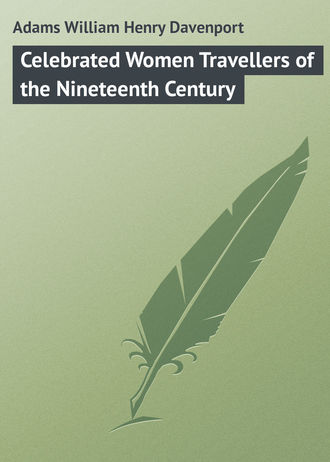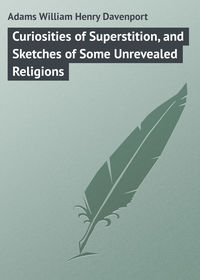 полная версия
полная версияCelebrated Women Travellers of the Nineteenth Century
According to Lady Brassey, the first glimpse of the far-spreading prairie was most striking in all its variations of colour. The true shade of the Pampas grass, when long, is a light dusty green; when short, it is a bright fresh green. But it frequently happens that, owing to the numerous prairie fires, either accidental or intentional, nothing is visible but a vast expanse of black charred ground, here and there relieved by a few patches of vivid green, where the grass is once more springing up under the influence of the rain.
"The road, or rather track, was in a bad condition, owing to the recent wet weather, and on each side of the five cañadas, or small rivers, which we had to ford, there were deep morasses, through which we had to struggle as best we could, with the mud up to our axle-trees. Just before arriving at the point where the stream had to be crossed, the horses were well flogged and urged on at a gallop, which they gallantly maintained until the other side was reached. Then we stopped to breathe the horses and to repair damages, generally finding that a trace had given way, or that some other part of the harness had shown signs of weakness. On one occasion we were delayed for a considerable time by the breaking of the splinter-bar, to repair which was a troublesome matter; indeed, I don't know how we should have managed if we had not met a native lad, who sold us his long lasso to bind the pieces together again. It was a lucky rencontre for us, as he was the only human being we saw during the whole of our drive of thirty miles, except the peon who brought us a change of horses half way.
"In the course of the journey we passed a large estancia, the road to which was marked by the dead bodies and skeletons of the poor beasts who had perished in the late droughts. Hundreds of them were lying about in every stage of decay, those more recently dead being surrounded by vultures and other carrion birds. The next cañada that we crossed was choked up with the carcasses of the unfortunate creatures who had struggled thus far for a last drink, and had then not had sufficient strength left to extricate themselves from the water. Herds of miserable-looking, half-starved cattle were also to be seen; the cows very little larger than their calves, and all apparently covered with the same rough shaggy coats. The pasture is not fine enough in this part of the country to carry sheep, but deer are frequently met with…
"The natives of these parts pass their lives in the saddle. Horses are used for almost every conceivable employment, from hunting and fishing to brick-making and butter-churning. Even the very beggars ride about on horseback. I have seen a photograph of one, with a police certificate of mendicancy hanging round his neck. Every domestic servant has his or her own horse, as a matter of course; and the maids are all provided with habits, in which they ride about on Sundays, from one estancia to another, to pay visits. In fishing, the horse is ridden into the water as far as he can go, and the net or rod is then made use of by his rider. At Buenos Ayres I have seen the poor animals all but swimming to the shore, with heavy carts and loads, from the ships anchored in the inner roads; for the water is so shallow, that only very small boats can go alongside the vessels, and the cargo is therefore transferred directly to the carts to save the trouble and expense of transhipment In out-of-the-way places, on the Pampas, where no churns exist, butter is made by putting milk into a goat-skin bag, attached by a long lasso to the saddle of a peon, who is then set to gallop a certain number of miles, with the bag bumping and jumping along the ground after him."29
When on her way to the Straits of Magellan, Lady Brassey saw something of one of the most terrible of "disasters at sea" – a ship on fire. The barque proved to be the Monkshaven, from Swansea, with a cargo of smelting coal for Valparaiso. The Sunbeam, on discovering her, hove-to, and sent a boat, which, as it was found impossible to save the burning vessel, brought her captain and crew on board, and afterwards saved most of their effects, with the ship's chronometers, charts, and papers.
"The poor little dingy belonging to the Monkshaven had been cast away as soon as the crew had disembarked from her, and there was something melancholy in seeing her slowly drift away to leeward, followed by her oars and various small articles, as if to rejoin the noble ship she had so lately quitted. The latter was now hove-to, under full sail, an occasional puff of smoke alone betraying the presence of the demon of destruction within. The sky was dark and lowering, the sunset red and lurid in its grandeur, the clouds numerous and threatening, the sea high and dark, with occasional streaks of white foam. Not a breath of wind was stirring. Everything portended a gale. As we lay slowly rolling from side to side, both ship and boat were sometimes plainly visible, and then again both would disappear, for what seemed an age, in the deep trough of the South Atlantic rollers."30
Something Lady Brassey has to say about the Patagonians, of whom the early voyagers brought home such mythical accounts. They owe their name to the fanciful credulity of Magellan, who thus immortalized his conviction that they were of gigantic proportions – Patagons, or Pentagons, that is, five cubits high. Sir Thomas Cavendish speaks of them as averaging seven to eight feet in stature. In truth, they are a fine robust race; well-limbed, of great strength, and above six feet in height; not giants, but men cast in a noble mould, and, physically, not inferior to the household regiments of the British army. They live the true nomadic life, being almost constantly on horseback, and dashing at headlong speed across their wide and open plains. Both men and women wear a long flowing mantle of skins, which reaches from the waist to the ankle, with a large loose piece dependent on one side, ready to be thrown over their heads whenever necessary; this is fastened by a large flat pin, hammered out either from the rough silver or from a dollar. They are no believers in cleanliness; but daub their bodies with paint and grease, especially the women. Their only weapons are knives and bolas, the latter of which they throw with a surprising accuracy of aim. That they possess even the rudest form of religious belief, or perform any religious ceremonies, has never yet been ascertained. Their food consists chiefly of the flesh of mares, and troops of these animals accompany them always on their excursions. They also eat ostrich flesh, as an exceptional bonne bouche, and birds' eggs, and fish, which the women catch.
Low as they are in the scale of humanity, from the standpoint of Western civilization, the Fuegians, or Canoe Indians, as they are generally called, because they live so much on the water, and have no fixed abodes on shore, sink much lower. They are cannibals, and, according to an old writer, "magpies in chatter, baboons in countenance, and imps in treachery." Whenever it is seen that a ship is in distress, or that a shipwrecked crew have been cast ashore, signal fires blaze on every prominent point, to convey the good news to the whole island population, and immediately the natives assemble, like the clans at Roderick Dhu's bidding, in Scott's "Lady of the Lake." But if all goes well, a vessel may pass through Magellan's Straits without discerning any sign of human life, the savages and their canoes lying hidden beneath the leafy screen of overhanging boughs. Those who frequent the Eastern part of "Fireland" (Tierra del Fuego) are clothed, in so far as they cover their nakedness at all, in a deerskin mantle descending to the waist; those at the Western end wear cloaks made from the skin of the sea otter. But most of them are quite naked. Their food is of the scantiest description, consisting almost wholly of shell-fish, sea-eggs, and fish generally, which they train their dogs to assist them in catching. These dogs are sent into the water at the mouth of a narrow creek or a small bay, where they bark and flounder about until the fish are frightened into the shallows.
Lady Brassey had an opportunity of seeing some Fuegians closely. When the Sunbeam was in English Reach, a canoe suddenly appeared on her port bow, and as she seemed making direct for the yacht, Sir Thomas ordered the engines to be slowed. Thereupon her occupants plied their paddles more furiously than before, shouting and gesticulating violently, one man waving a skin round his head with an energy of action that threatened to capsize his frail craft – frail, in truth, for it was made only of rough planks rudely fastened together with the sinews of animals. A rope was thrown to them, and they came alongside, shouting "Tabáco, galléta" (biscuit), a supply of which they received, in exchange for the skin they had been waving; "whereupon the two men stripped themselves of the skin mantles they were wearing, made of eight or ten sea-otter skins, sewed together with finer sinews than those used for the boat, and handed them up, clamouring for more tobacco, which we gave them, together with some beads and knives." Finally, the woman, influenced by so fair an example, parted with her sole garment, in return for a little more tobacco, some beads, and some looking-glasses, which were thrown into the canoe.
"The party consisted of a man, a woman, and a lad; and, I think," says Lady Brassey, "I never saw delight more strongly depicted than it was on the faces of the two latter, when they handled, for the first time in their lives probably, some strings of blue, red, and green glass beads. They had two rough pots, made of bark, in the boat, which they also sold, after which they reluctantly departed, quite naked but very happy, shouting and jabbering away in the most inarticulate language imaginable. It was with great difficulty we could make them let go the rope, when we went ahead, and I was quite afraid they would be upset. They were all fat and healthy-looking, and, though not handsome, their appearance was by no means repulsive; the countenance of the woman, especially, wore quite a pleasing expression, when lighted up with smiles at the sight of the beads and looking-glasses. The bottom of their canoe was covered with branches, amongst which the ashes of a recent fire were distinguishable. Their paddles were of the very roughest description, consisting simply of split branches of trees, with wider pieces tied on at one end with the sinews of birds or beasts."31
A fine contrast to these gloomy scenes is presented by Lady Brassey's description of a coral island, one of those almost innumerable gems which stud the broad bosom of the Pacific, like emeralds embossed on a shield of azure and silver. It was the first land she touched in the great South Sea. A reef of glowing coral enclosed a tranquil lagoon, to which the green shores of the island gently sloped. The beauty of this lagoon would need a Ruskin's pen to reproduce it in all its exquisite and manifold colouring. Submarine coral forests, of every hue, enriched with sea-flowers, anemones, and echinidæ, of unimaginable brilliancy; shoals of the brightest fish flashing in and out like rainbow gleams; shells of gorgeous lustre, moving slowly along with their living inmates; fairy foliage of fantastic sea-weeds stirred into tremulous motion by the gliding wave; upon these the enchanted gaze dwelt in the depths of the lagoon, while the surface glowed with every possible and exquisite tint, from the palest aqua marina to the brightest emerald; from the pure light blue of the turquoise to the "deeply, darkly, beautifully blue" of the sapphire; while here and there the glassy wave was broken up by patches of red, brown, and green coral rising from the mass below. A rich growth of tropical vegetation encumbered the shore, stretching down to the very border of the ribbed sands; palms and cocoa-nuts lifted high their slender, shapely trunks; while in and out flitted the picturesque figures of native women in red, blue, and green garments, and of men in motley costumes, loaded with fish, fowls, and bunches of cocoa-nuts.
On the 2nd of December the Sunbeam arrived at the "Queen of the Pacific," the lovely island of Tahiti, or, as it was first called, Otaheite. Here Lady Brassey found herself in the midst of a fairy-like drama, to describe which is almost impossible, so bewildering was it in the brightness and variety of its colouring. "The magnolias and yellow and scarlet hibiscus, overshadowing the water, the velvety turf, on to which one steps from the boat, the white road running between rows of wooden houses, whose little gardens are a mass of flowers, the men and women clad in the gayest robes and decked with flowers, the piles of unfamiliar fruit lying on the grass, waiting to be transported to the coasting vessels in the harbour, the wide-spreading background of hills clad in verdure to their summits – these are but a few of the objects which greet the new comer on his first contact with the shore."
The impression produced by the first view was deepened by all that Lady Brassey saw afterwards. On sea and shore, or in the heart of the island groves, all was new, beautiful, striking. There was a strange light in the firmament above, a glow in the wave beneath, such as she had not seen elsewhere; for it was with open hands that Nature poured out her dower upon Tahiti.
She went for a ride; the path carried her through a thick growth of palm, orange, guava, and other tropical trees, some of which were thickly draped with luxuriant creepers. Conspicuous among the latter shone a gorgeous passion flower, with orange-coloured fruit as big as pumpkins, that overspread everything with its vigour. The path was everywhere narrow and sometimes steep; and frequently the horseman had almost to creep under the close thick crop of interlacing boughs. Crossing several bright little streams, it climbed to the summit of an eminence which commanded on the one side a prospect of a picturesque waterfall, on the other side of a deep ravine. A river issuing from a narrow cleft in the rock takes but one mad leap from the edge of the precipice into the valley below, a leap of 600 feet. "First one sees the rush of blue water, gradually changing in its descent to a cloud of white spray, which in its turn is lost in a rainbow of mist. Imagine that from beneath the shade of feathery palms and broad-leaved bananas through a network of ferns and creepers you are looking upon the Staubbach, in Switzerland, magnified in height, and with a background of verdure-clad mountains, and you will have some idea of the fall of Fuatawah."32
With no spot that she touched at in her long ocean wanderings does Lady Brassey seem to have been so delighted as with Tahiti. "Sometimes," she says, "I think that all I have seen must be only a long vision, and that too soon I shall awaken to the cold reality; the flowers, the fruit, the colours worn by every one, the whole scene and its surroundings, seem almost too fairy-like to have an actual existence." Human nature is, of course, the same everywhere: vice and sorrow prevail at Tahiti as in the reeking slums and lanes of great cities. It is only of the outward aspect of things that Lady Brassey speaks, for she saw none other, and assuredly at Tahiti that is fair exceedingly, and well calculated to charm a cultivated taste, to fill a refined mind with memories of beauty.
From Tahiti we pass on to Hawaii, the chief island of the Sandwich group, and the centre of a civilization that may one day influence the direction of the great currents of commerce in the Pacific. The Sunbeam arrived there on the 22nd of December.
"It was a clear afternoon. The mountains, Mauna Kea and Mauna Loa, could be plainly seen from top to bottom, their giant crests rising nearly 14,000 feet above our heads, their tree and fine clad slopes seamed with deep gulches or ravines, down each of which a fertilizing river ran into the sea. Inside the reef the white coral shore, on which the waves seemed too lazy to break, is fringed with a belt of cocoa-nut palms, amongst which, as well as on the hillside, the little white houses are prettily dotted. All are surrounded by gardens, so full of flowers that the bright patches of colour were plainly visible even from the deck of the yacht.
"Having landed, we went for a stroll, among neat houses and pretty gardens, to the suspension-bridge over the river, followed by a crowd of girls, all decorated with wreaths and garlands, and wearing almost the same dress that we had seen at Tahiti – a coloured, long-sleeved, loose gown reaching to the feet. The natives here appear to affect duller colours than those we have lately been accustomed to – lilac, drab, brown, and other dark prints being the favourite tints. Whenever I stopped to look at a view, one of the girls would come behind me and throw a lei of flowers over my head, fasten it round my neck, and then run away laughing, to a distance, to judge of effect. The consequence was that, before the end of our walk, I had about a dozen wreaths of various colours and lengths, hanging round me, till I felt almost as if I had a fur tippet on, they made me so hot; and yet I did not like to take them off, for fear of hurting the poor girls' feelings."
Wherever she went Lady Brassey seems to have commanded special attention; partly no doubt due to her own personal qualities, and partly to the fact that English ladies are rare visitors in the Polynesian islands – and especially an English lady, the wife of a member of parliament, who sails round the world in her husband's yacht!
Lady Brassey made, of course, an excursion to the great volcano of Kilauea, of which Miss Bird has furnished a singularly fine description. Lady Brassey's sketch is not so elaborate or powerful or fully coloured, but it has a charm of its own in its unassuming simplicity. Let us go with her on a visit to the two craters, the old and the new.
And, first of all, we descend the precipice, 300 feet in depth, which forms the wall of the original crater, but now blooming with a prodigal vegetation. In many places the incline is so steep that zigzag flights of wooden steps have been inserted here and there in the face of the cliff in order to facilitate the descent. At the bottom we step on to a surface of cold boiled lava, and even here, in every chink where a little soil has collected, Nature asserts her robust vitality, and delicate little ferns put forth their green fronds to feel the light. An extraordinary appearance did that vast lava field present, contorted as it was into every imaginable shape and form, according to the temperature it had attained and the rapidity with which it had cooled. Here and there a patch looked not unlike the contents of a caldron, which had been petrified in the very act of boiling; elsewhere the iridescent lava had congealed into wave-like ridges, or huge coils of rope, closely twisted together. Again it might be seen in the semblance of a collection of organ-pipes, or accumulated into mounds and cones of various dimensions. As our travellers moved forward, they felt that the lava grew hotter and hotter, and from every fissure issued gaseous fumes, which seriously affected their noses and throats; till, at last, when passed to leeward of the lava-river rolling from the lake, they were almost suffocated by the vapour, and it was with difficulty they pursued their advance. The lava was more glassy and had a look of greater transparency, as if it had been fused at an exceptionally high temperature; and the crystals of alum, sulphur, and other minerals with which it abounded, reflected the light in bright prismatic colours. In some places the transparency was complete, and beneath it might easily be seen the long streaks of that fibrous kind of lava, connected with a superstition of the natives, which is known as "Pile's hair."
Lady Brassey and her companions reached, at last, the foot of the present active crater, whence the molten contents of the terrestrial interior are continually pouring forth in a lurid flood. With some difficulty they gained the summit – to stand, silent and spell-bound, in contemplation of a spectacle which more than realizes the terrors of the ancient Phlegethon. The precipice overhung a basin of molten fire, measuring nearly a mile across. With a clang, a clash, and a roar, like that of breakers on a rocky coast, waves of blood-red, fiery, liquid lava dashed against the opposing cliffs, and flung their spume high up in the air – waves which were never still, but rolled onwards incessantly to the charge, and as incessantly retired – hustling one another angrily, and hissing and boiling and bubbling, like a sea chafed by adverse wind and current. A dull dark red, like that of the lees of wine, seems the normal colour of the surging lava, which was covered, however, with a thin grey scum – this scum, or froth, being every moment and everywhere broken by eddies and jets and whirlpools of red and yellow fire, and occasionally thrown back on either side by the force and rush of swift golden-tinted rivers. On one side of the lake the principal object of attack was an island, dark and craggy, against which the lava-waves rolled with impetuous fury. On the other, they swept precipitately into a great cavern, carrying away the gigantic stalactites which hung at its entrance, and filling it with a thunderous roar like that of contending armies.
Scenes there are many in this wide world of ours which neither the craft of the scribe nor the skill of the painter can hope to reproduce, and this is one of them. It is awful in its grandeur, terrible in its sublimity, like Milton's Satan. It fascinates, and yet repels; charms the eye, while it chills the heart. One trembles with the sense of a dire terrific power, which at any moment may leap into the clay, and sweep the shattered island into destruction. But dreadful as it is by day, a deeper dread attaches to it by night, when the glare of those leaping fountains and rolling billows of molten lava is reflected athwart the darkness of heaven. And as the night advances and the darkness increases, a wonderful phantasmagoria of colour invests the fiery lake – jet black merges suddenly into palest grey; the deepest maroon changes, through cherry and scarlet, into the exquisitest hues of pink and blue and violet; the richest brown pales, through orange and yellow, into a delicate straw. Lady Brassey adds that there was yet another shade, which can be described only by the term "molten lava colour." The wreaths and wheeling clouds of smoke and vapour were by all these borrowed lights and tints translated into beautiful gleaming mist-like creations – belonging neither to earth nor air, but born of the molten flame and seething fire – which seemed splendidly and appropriately displayed against the amphitheatre of black peaks, pinnacles, and crags rising in the background. Of these great pieces would sometimes break off, and with a crash fall into the burning lake, there to be remelted and in due time thrown up anew.33
The time spent at Honolulu by Lady Brassey was by no means wasted. She kept both eyes and ears well open, and suffered nothing to escape her which could throw any light on the manners and customs of the Hawaiian population. Though not a deep, she was a close and an accurate observer; and her book may advantageously be consulted by others than the "general reader."
The Hawaiians, as a people with a good deal of leisure, upon whose shoulders as yet civilization has laid none of its heavier burdens, are naturally prone to amusement, and cultivate their numerous national sports with a good deal of energy and skill. Foremost amongst these is the well-known pastime of surf-swimming – a pastime the origin of which it is not difficult to understand. It is one in which both men and women join. Armed with a surf-board – a flat piece of wood, about four feet long by two feet wide, pointed at each end – which they put edge-wise in front of them, they swim out into the broad and beautiful bay, and dive under the surf-crested billows of the Pacific. When at a certain distance from the land, a distance regulated by the swimmer's measure of strength and address, he chooses a large wave, and either astride, or kneeling, or standing upon his board, allows himself to be swept in shore upon its curling crest with headlong speed. The spectator might almost fancy him to be mounted upon the sea-horse of ancient myths, and holding its grey curling mane, as it snorts and champs and plunges shoreward, wrapped in spray and foam. To this vigorous sport the Hawaiians are exceedingly partial. They are almost to the manner born, for from their earliest childhood they live an amphibious life, and never seem happier than when they are diving, swimming, bathing, or playing tricks in the bright emerald waters that wash the smiling shores of their favoured isle, or in those of the pleasant river that flows by the groves and gardens of Hilo.







